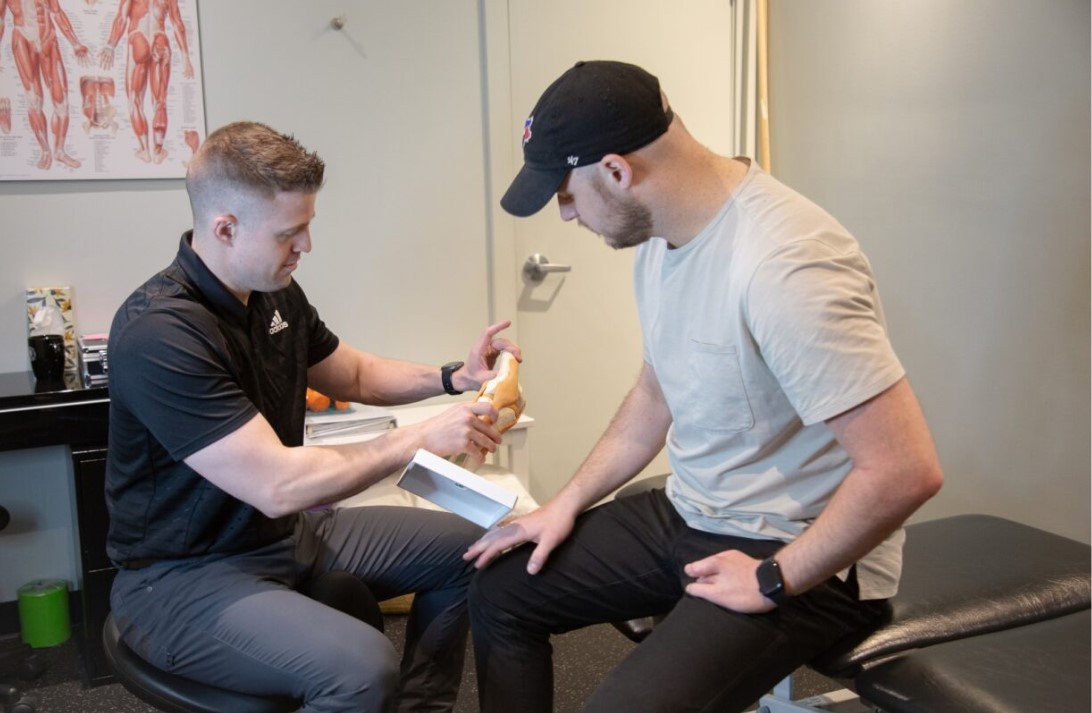Causes of Knee Pain

Knee pain can be a result of:
- Injury, such as a ruptured ligament or torn cartilage
- Tendonitis/Tendinosis (an overuse of a tendon). If it’s associated with the patellar tendon, we call this jumper’s knee (a common condition in sports, especially basketball, that occurs when the force of hitting the ground after jumping high puts a strain on the tendon).
- Bursitis, which is inflammation of the bursae, the small fluid-filled sacs that cushion the knee joint.
- Medical conditions like arthritis, gout and infections
- Repeated stress on the knee while walking, running, bending
Sign and Symptoms
- Pain that can range from mild to severe
- Swelling and stiffness
- Redness and warm to touch
- Weakness or feeling unstable on your feet
- Popping or crunching noises accompanied by pain
- Inability to fully bend or straighten the knee
How Chiropractors Treat Knee Pain

Here at MYo Lab, we take a multidisciplinary approach to knee pain. We believe that knee pain is typically related to how you move.
When managing knee pain, we make sure the muscles of your hip and lower leg function optimally. The hip muscles are often tight, overused, or weakened due to basic human biomechanics. Tight gluteal muscles can cause rotational forces on the upper leg, while dysfunctional muscles in the lower leg and calf can lead to abnormal ankle movement patterns.
These restrictions, abnormal movements, and muscle weaknesses in the lower and upper leg exert unusual forces on the knee’s bones—the femur and tibia. Over time, these abnormal forces can cause knee pain.
To correct these movement patterns, a combination of Chiropractic and Massage Therapy is recommended to alleviate pain initially, followed by Physiotherapy to maintain pain-free function through exercise. There are also other modalities that we may use depending on the extent of the pain.
Chiropractic Adjustments
Chiropractors often address misalignments in the spine (subluxations) that can affect overall body mechanics and lead to knee pain. By correcting spinal alignment, they aim to improve posture and reduce undue stress on the knees.
Direct adjustments to the knee joint itself also help improve alignment, enhance joint function, and relieve pain. This can involve gentle manipulation to increase the range of motion and reduce stiffness.
Massage Therapy
Massage techniques can help reduce muscle tension around the knee, improve blood flow, and promote healing. It can also help with pain relief and reduce inflammation.
Physiotherapy
Our Physiotherapists then manage the properly aligned structures with tailored exercises to correct movement patterns, ensuring long-term results and preventing knee pain from recurring in daily life.
Modalities and Other Techniques
Low-level laser therapy (LLLT)/Cold Laser can be used to reduce pain and inflammation and to accelerate tissue repair. Shockwave Therapy in the form of low-level electrical currents may be used to reduce pain and promote muscle function.
Custom Orthotics
Custom-made orthotics can correct foot and gait issues that contribute to knee pain, providing better alignment and support.






